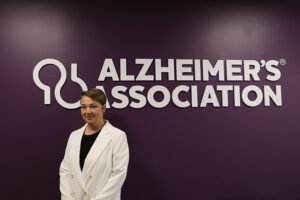Based in Syracuse, new director will lead three Upstate New York chapters of Alzheimer’s Association, following a new leadership restructuring, which previously had individual directors for each chapter
By Norah Machia

The new executive director for the Upstate New York Chapters of the Alzheimer’s Association is quite optimistic about the current research being done to improve treatment options for patients and their families struggling with the disease.
“I’m incredibly hopeful the treatments for Alzheimer’s and dementia will change,” said Kathleen “Kate” Flannery of Syracuse.
The Alzheimer’s Association has been working to get information about the current research to patients and their families so they may have hope as well, she added.
Alzheimer’s disease is a degenerative brain disease and the most common form of dementia, according to the Alzheimer’s Association. Dementia is not a specific disease, but it’s an overall term that describes a group of symptoms. It’s estimated that 55 million people worldwide are living with Alzheimer’s and other dementias.
There are currently medications available that temporarily improve symptoms of memory loss and problems with thinking and reasoning. Although these treatments may help to improve symptoms in some patients, they don’t stop the progression of the disease.
New research is focused on potential Alzheimer’s treatments that could actually slow down or stop the disease process, Flannery explained. The Alzheimer’s Association is the largest nonprofit funder of Alzheimer’s research and is committed to the development of new treatments, prevention and ultimately, a cure for the disease.
One of the major roles of the nonprofit organization is to share the latest advances in Alzheimer’s treatment with the public. “We need to raise the level of information out there,” Flannery said. “We’ve become better educated about diagnosis and treatment options.”
The organization offers numerous resources to help families and caregivers, including information about arranging for home care services or finding a memory-care-certified nursing home or assisted living community.
“There is more awareness of the needs of family members and caregivers for those with Alzheimer’s disease,” said Flannery. “It’s one of the biggest issues we’re facing.”
The agency provides information on what to expect in the different stages of the disease and a variety of support programs. It also operates a free 24/7 helpline (1-800-272-3900) that is staffed by specialists and master’s-level clinicians who offer confidential support.
“It’s incredibly difficult to watch someone you love navigate these symptoms,” she said. “We’re hoping that will change in the near future.”
In the meantime, there are many resources available to help both patients and their families, and “it’s important that caregivers take care of themselves as well,” she said.
The organization is also working to respond to the diverse needs of communities and reach out to underserved populations to provide information about resources in their areas, she said. “We’re also working to help debunk any myths out there” about Alzheimer’s disease and dementia, she added.
Some of the latest research in Alzheimer’s disease prevention includes taking a more holistic and integrative approach to the disease, Flannery said. This includes actively engaging the brain in new tasks and finding meaning and purpose in life.
In her new role, Flannery will lead the Western New York, Rochester/Finger Lakes region and Central New York chapters. She is responsible for the overall strategic and operational functions, including programming, fundraising, community engagement, government and private grant funding, media relations and the growth and delivery of the association’s mission.
Her position as executive director for Upstate New York chapters is part of a new leadership structure for the three chapters, which previously had individual directors. The new structure also includes the promotion of Amanda Nobrega to vice president of programs for Upstate New York and Cathy Wilde to director of marketing and public relations for the Western New York, Rochester/Finger Lakes Region and Central New York Chapter.
“This new position was a great opportunity for me,” said Flannery. “The mission of the Alzheimer’s Association really spoke to my heart.”
The changes in leadership will have a very positive impact on the communities, she added. “We’re streamlining operational components and coordination and being smart stewards of resources,” she said.
Prior to the new position with the Alzheimer’s Association, Flannery had served as executive director for the Office of Community Engagement Planning at Syracuse University and director of mission outreach and education for Francis House, a community care home in Syracuse for People facing terminal illness. She has also worked as an executive director of the Susan G. Komen organization, overseeing six affiliates encompassing 49 New York counties, and was responsible for growing “Race for the Cure” from $250,000 to $1 million.
The three Upstate New York Alzheimer’s Association offices “will be staying open in the communities and no services will be minimized” with the leadership structure changes, said Flannery. “We’re actually hoping to be more impactful by sharing the professional skill sets of different staff.”
For more information about the Alzheimer’s Association, visit www.alz.org (the site can navigate users to individual chapters).
The website has a wealth of information, including safety tips to remain independent for as long as possible in a safe environment as the disease progresses.
Those safety issues include driving, accommodations in the home, taking medications and wandering. The Alzheimer’s Association provides information about enrolling in a wandering response service to help locate someone who unexpectedly leaves the home.

